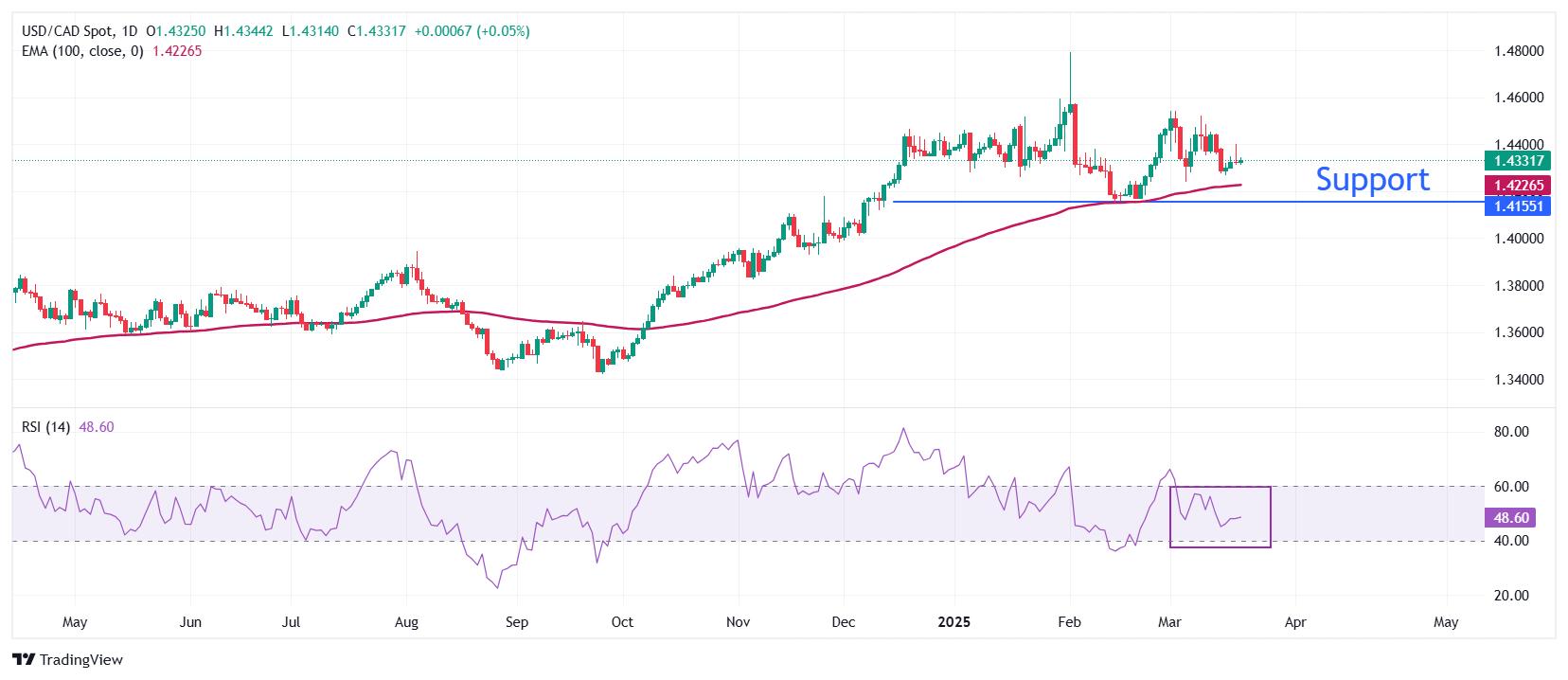USD/CAD Price Forecast: Trades sideways above 1.4300
- USD/CAD oscillates inside Thursday’s trading range around 1.4330.
- The Fed is in no hurry to move to interest rate cuts amid elevated consumer inflation expectations.
- Market experts see the BoC reducing interest rates again in April.
The USD/CAD pair ticks higher to near 1.4330 in European trading hours on Friday but remains inside Thursday’s trading range. The Loonie pair is marginally higher even though the US Dollar (USD) trades strongly, suggesting the Canadian Dollar (CAD) also trades firmly.
Canadian Dollar PRICE Today
The table below shows the percentage change of Canadian Dollar (CAD) against listed major currencies today. Canadian Dollar was the strongest against the Japanese Yen.
| USD | EUR | GBP | JPY | CAD | AUD | NZD | CHF | |
|---|---|---|---|---|---|---|---|---|
| USD | 0.17% | 0.17% | 0.40% | 0.02% | 0.22% | -0.04% | 0.07% | |
| EUR | -0.17% | 0.02% | 0.26% | -0.12% | 0.06% | -0.14% | -0.11% | |
| GBP | -0.17% | -0.02% | 0.23% | -0.14% | 0.05% | -0.15% | -0.12% | |
| JPY | -0.40% | -0.26% | -0.23% | -0.39% | -0.19% | -0.41% | -0.39% | |
| CAD | -0.02% | 0.12% | 0.14% | 0.39% | 0.18% | -0.01% | 0.01% | |
| AUD | -0.22% | -0.06% | -0.05% | 0.19% | -0.18% | -0.20% | -0.26% | |
| NZD | 0.04% | 0.14% | 0.15% | 0.41% | 0.00% | 0.20% | 0.03% | |
| CHF | -0.07% | 0.11% | 0.12% | 0.39% | -0.01% | 0.26% | -0.03% |
The heat map shows percentage changes of major currencies against each other. The base currency is picked from the left column, while the quote currency is picked from the top row. For example, if you pick the Canadian Dollar from the left column and move along the horizontal line to the US Dollar, the percentage change displayed in the box will represent CAD (base)/USD (quote).
The US Dollar Index (DXY), which tracks the Greenback’s value against six major currencies, moves higher to near 104.10. The Greenback gains as the Federal Reserve (Fed) has expressed that interest rates will not be reduced in the near term.
On Wednesday, the Fed left interest rates unchanged in the range of 4.25%-4.50%, as expected, and stuck with their projection of cutting interest rates two times this year. Fed Chair Jerome Powell stated that monetary policy adjustments are not ideal in the current scenario, given “unusually elevated” uncertainty due to new economic policies under the leadership of United States (US) President Trump.
Meanwhile, the Canadian Dollar trades higher even though market participants are confident that the Bank of Canada (BoC) will cut interest rates again. Analysts at Bank of America (BofA) expect the BoC to cut interest rates by 25 basis points (bps) to 2.50% in April but cautioned that the decision could be influenced by US "reciprocal tariffs" and the March Consumer Price Index (CPI) data.
USD/CAD holds above the 100-period Exponential Moving Average (EMA), which is around 1.4226, suggesting that the overall trend is bullish.
The 14-period Relative Strength Index (RSI) oscillates in the 40.00-60.00 range, indicating a sideways trend.
Going forward, an upside move above the March 10 high of 1.4470 will open the door toward the psychological resistance of 1.4500 and the January 30 high of 1.4595.
On the contrary, a breakdown below the February 14 low of 1.4151 by the pair would expose it to the December 9 low of 1.4094, followed by the December 6 low of 1.4020.
USD/CAD daily chart

US Dollar FAQs
The US Dollar (USD) is the official currency of the United States of America, and the ‘de facto’ currency of a significant number of other countries where it is found in circulation alongside local notes. It is the most heavily traded currency in the world, accounting for over 88% of all global foreign exchange turnover, or an average of $6.6 trillion in transactions per day, according to data from 2022. Following the second world war, the USD took over from the British Pound as the world’s reserve currency. For most of its history, the US Dollar was backed by Gold, until the Bretton Woods Agreement in 1971 when the Gold Standard went away.
The most important single factor impacting on the value of the US Dollar is monetary policy, which is shaped by the Federal Reserve (Fed). The Fed has two mandates: to achieve price stability (control inflation) and foster full employment. Its primary tool to achieve these two goals is by adjusting interest rates. When prices are rising too quickly and inflation is above the Fed’s 2% target, the Fed will raise rates, which helps the USD value. When inflation falls below 2% or the Unemployment Rate is too high, the Fed may lower interest rates, which weighs on the Greenback.
In extreme situations, the Federal Reserve can also print more Dollars and enact quantitative easing (QE). QE is the process by which the Fed substantially increases the flow of credit in a stuck financial system. It is a non-standard policy measure used when credit has dried up because banks will not lend to each other (out of the fear of counterparty default). It is a last resort when simply lowering interest rates is unlikely to achieve the necessary result. It was the Fed’s weapon of choice to combat the credit crunch that occurred during the Great Financial Crisis in 2008. It involves the Fed printing more Dollars and using them to buy US government bonds predominantly from financial institutions. QE usually leads to a weaker US Dollar.
Quantitative tightening (QT) is the reverse process whereby the Federal Reserve stops buying bonds from financial institutions and does not reinvest the principal from the bonds it holds maturing in new purchases. It is usually positive for the US Dollar.
